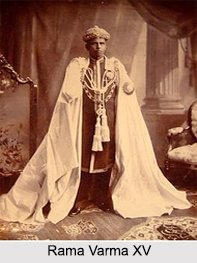 Medieval History of Thissur District explains the rule of Kingdom of Cochin. The main revenue was coming from Muziris Port which was destroyed due to the flood. But there is no extant written evidence about the emergence of Kingdom of Cochin or of the Cochin Royal Family, also known as Perumpadapu Swaroopam.
Medieval History of Thissur District explains the rule of Kingdom of Cochin. The main revenue was coming from Muziris Port which was destroyed due to the flood. But there is no extant written evidence about the emergence of Kingdom of Cochin or of the Cochin Royal Family, also known as Perumpadapu Swaroopam.
Perumpadapu Grandavari
The Perumpadapu Grandavari, a historical medieval book of Thissur contains an additional account of the dynastic origins. The last Thavazhi of Perumpadapu Swaroopam came into existence on the Kaliyuga day Shodashangamsurajyam. Cheraman Perumal divided the land in half, 17 amsha north of Neelaeswaram and 17 amsha south, totaling 34 amsha, and gave his powers to nephews and sons.
Keralolpathi
Keralolpathi recorded the division of his kingdom in 345AD.
Kulasekharas of Mahodayapuram
The history of Thrissur from the 9th to the 12th centuries is the history of Kulasekharas of Mahodayapuram This is the history of the rise and growth of Perumpadapu Swaroopam. Perumpadappu Swarupam had its capital at different places. According to the literary works of the period, the Perumpadapu Swaroopam had its headquarters at Mahodayapuyram and had a number of Naduvazhies in southern Kerala. Central Kerala was recognized as the supremacy of the Perumpadappu Moopil and he is even referred to as the `Kerala Chakravarthi` in the `Sivavilasam` and some other works.
Pudu Vaipu era
The landmarks in the history of the Perumpadapu Swaroopam are the foundation of a new era called Pudu Vaipu era. The Pudu Vaipu era is traditionally believed to have commenced from the date on which the island of Vypeen was thrown from the sea.
Age of Wars in Thissur
The 14th and 15th centuries constituted a period of aggressive wars in the course of which the Zamorins of Calicut acquired a large part of the present Thrissur district. In the subsequent centuries, the Portuguese traders dominated the scene. By the beginning of the 17th century the Portuguese power in Kerala was on the verge of collapse. About this time other European powers like the Dutch East India Company and the British East India Company appeared on the scene and challenged the Portuguese. Perumpadappu Swarupam helped the Dutch in getting a footing on the Kerala coast. As the Kerala chiefs were conscious of the impending doom of the Portuguese, they looked upon the Dutch as the rising power and extended a hearty welcome to them.
Flood of 1341
The flood of the river Periyar in 1341 resulted in the splitting of the left branch of the river into two just before Aluva. The flood silted the right branch and the natural harbour at the mouth of the river, and resulted in the creation of a new harbour at Kochi. An island was formed with the name Vypinkara between Vypin to Munambam during the flood. During this time there was the rise of the Samoothiri Rajas of Kozhikode.
Cranganore Fort
Cranganore Fort was built by Portuguese in 1523 and later in 1565 it was enlarged. It is also known as Kottappuram Fort. The Dutch took possession of the fort in 1661. In 1776, Tipu Sultan seized control of fort. The Dutch wrested it back from Tipu Sultan, but the fort eventually came under the control of Tipu Sultan, who destroyed it in the following year. The remains of the fort show that the original fort wall was 18 feet in thickness. The ruin is also known as Tipu`s fort.
Mysorean Invasion
The 1773 conquest of the Mysore King Hyder Ali in the Malabar region descended to Kochi. The Kochi Raja had to pay a subsidy of one lakh of Ikkeri Pagodas (equaling 400,000 modern rupees). Later on, in 1776, Hyder Ali captured Thrissur, which was under the Kingdom of Kochi. Thus, the Raja was forced to become a tributary of Mysore and to pay a nuzzar of 100,000 of Pagodas and 4 elephants and annual tribute of 30,000 Pagodas. His son Tipu Sultan`s invasion had an adverse impact on the Syrian Malabar Nasrani community of the Malabar coast. Many churches in Malabar and Cochin were damaged. Tipu`s army set fire to the church at Palayoor and attacked the Ollur Church in 1790. Furthermore, the Arthat church and the Ambazhakkad seminary was also destroyed. Over the course of this invasion, many Syrian Malabar Nasrani were killed or forcibly converted to Islam. Most of the coconut, areca nut, pepper and cashew plantations held by the Syrian Malabar farmers were also indiscriminately destroyed by the invading army. The Syrian Christian community fled Calicut and small towns like Arthat to new centers like Kunnamkulam, Chalakudi, Ennakadu, Cheppadu, Kannankode, Mavelikkara, etc. where there were already Christians. They were given refuge by Sakthan Tamburan, the ruler of Cochin and Karthika Thirunal, the ruler of Travancore, who gave them lands, plantations and encouraged their business. Colonel Macqulay, the British resident of Travancore also helped them.
Rule of Sakthan Thampuran
In 1790, Raja Rama Varma popularly known as Sakthan Thampuran ascended the throne of Kingdom of Cochin. With the accession of this ruler, the modern period in the history of Kochi and the Thrissur District and the city begin.



















